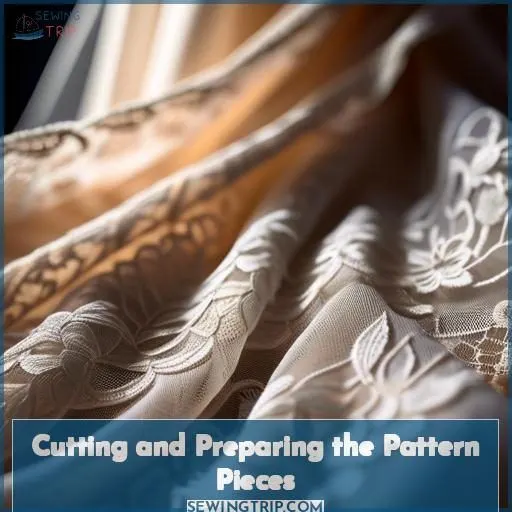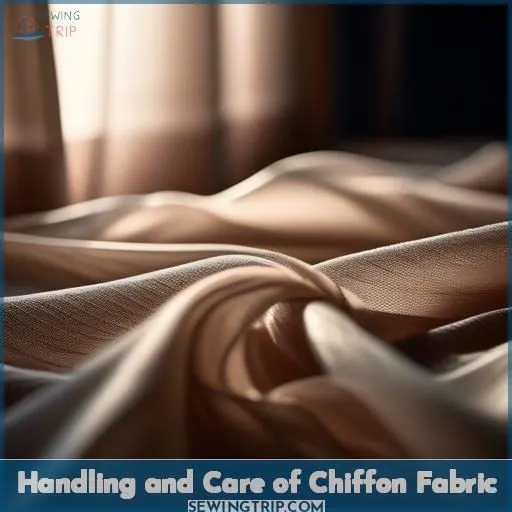This site is supported by our readers. We may earn a commission, at no cost to you, if you purchase through links.

To create a chiffon dress with a lining that adds structure and elegance, you’ll need to choose the right lining fabric, cut and prepare the pattern pieces**, and use sewing techniques suited to chiffon.
First, select a lightweight, breathable fabric like spandex, polyester, silk, cotton, or acetate for your lining. Prepare the lining fabric by cleaning, pressing, and cutting it precisely.
Then, use French seams, underlining, and serging to sew the skirt and dress layers together. Finish the neckline with facings and hem the layers separately for a clean finish.
Remember to handle and care for the chiffon fabric properly to guarantee a long-lasting, beautiful dress.
Table Of Contents
Key Takeaways
- Choose a lightweight, breathable lining fabric like spandex, polyester, silk, cotton, or acetate for your chiffon dress.
- Use French seams, underlining, and serging to sew the skirt and dress layers together.
- Finish the neckline with facings and hem the layers separately for a clean finish.
- Handle and care for the chiffon fabric properly to guarantee a long-lasting, beautiful dress.
How to Sew a Chiffon Dress With Lining?
To sew a chiffon dress with lining, you should first underline the chiffon fabric with a stronger backing, such as cotton batiste, to provide structure and prevent the dress from being too sheer.
Then, sew the lining fabric to the chiffon in the seam allowances, treating them as one piece.
You can also use a serger to finish the seams and prevent fraying.
Remember to use a new needle and rotary blade, and skip fabric shears and weights, as the chiffon fabric shifts easily.
Choosing the Right Lining Fabric
Choosing the appropriate lining fabric for your chiffon dress is essential to achieving both comfort and the intended silhouette. Take into account the fabric’s weight, breathability, and how it enhances the drape of the chiffon to guarantee a seamless finish.
Lining Fabric Selection
When selecting a lining fabric for your chiffon dress, consider its compatibility with the outer fabric.
A lightweight and breathable lining, such as spandex, polyester, silk, cotton, or acetate, can enhance the drape and prevent the chiffon from clinging to your body.
Choose a neutral color for the lining to avoid showing through the sheer fabric.
Test the lining fabric with the outer fabric to establish a successful combination.
For heavier individuals, consider a double lining, boning or structure, wider straps, and reinforced seams.
Lining Fabric Properties
After narrowing down your lining choices, let’s delve into the specifics.
The appropriate lining weight and drape can determine the success or failure of your chiffon masterpiece. Choose silk, batiste, or organza to guarantee a luxurious feel and movement.
A neutral lining hue with a suggestion of luster enhances the elegance of the outer fabric.
Bear in mind, attention to detail is crucial—consider French seams and precise hemming.
Lining Fabric Preparation
When preparing your chiffon dress for lining, there are several steps to follow to achieve a professional outcome. Here are four key points to keep in mind:
- Choose the appropriate lining fabric: Select a lining fabric that complements the outer fabric and the desired flow. Consider factors such as weight, texture, and breathability when making your choice.
- Prepare the lining fabric: Before cutting, make sure the lining fabric is clean and pressed. Use a rotary cutter and marking tools to precisely cut the lining pieces.
- Baste the lining to the outer fabric: Use a single thickness of thread and brightly colored basting thread to baste the lining to the outer fabric. This will help you check the fit and ease of movement before sewing the final seams.
- Finish the seams: Use French seams for a clean finish, and serge seams that aren’t sewn with French seams. Hem the lining separately to achieve a clean finish.
Remember to test the lining fabric with the outer fabric to ensure compatibility. A lightweight, breathable lining with a slight sheen can enhance the drape and appearance of the chiffon dress.
Cutting and Preparing the Pattern Pieces
Cutting and preparing the pattern pieces for a chiffon dress with lining can be a delicate process, but with the right tools and techniques, it can be done with ease. Here are some tips and tricks to guarantee a successful outcome:
- Use a single layer of fabric: Chiffon is a lightweight fabric that can shift and move easily. To minimize this, try to cut the pattern pieces on a single layer, rather than cutting through the fold. This will also help prevent any potential misalignment of pattern pieces.
- Lay down a piece of tissue paper: Place a piece of tissue paper on your cutting surface, then lay the chiffon fabric on top. The tissue paper will help the fabric cling to it, making it easier to cut and handle.
- Mark notches with tailors tacks: Use tailors tacks to mark notches on the pattern pieces. This will help you align the pieces correctly when sewing.
- Hand baste the layers: Before cutting, hand baste the layers of the bodice together. Use a single thickness of thread and a brightly colored thread for easy identification. This will help you visualize how the pieces will fit together and guarantee that the lining and outer fabric are aligned correctly.
- Use sharp scissors or rotary cutter: Always use sharp scissors or a rotary cutter when cutting chiffon. Dull scissors can snag the fabric, leading to uneven cuts.
- Cut with precision: When cutting, make sure to cut through both the fabric and the tissue paper at the same time. This will help maintain the accuracy of your cuts.
- Use pattern weights or sharp pins: Secure the pattern pieces in place with either pattern weights or sharp pins. This will prevent the fabric from shifting during the cutting process.
Sewing Techniques for Chiffon Dresses
To construct a chiffon dress with lining, it’s imperative to employ the appropriate techniques to guarantee a polished appearance. Here are some suggestions:
- French Seams: Utilize French seams to complete both layers of the skirt, as they hinder unraveling and offer a tidy finish.
- Underlining: Enhance stability and conceal seam allowances by incorporating an underlining.
- Serging Seams: Overcast seams that aren’t sewn with French seams to prevent disintegration.
- Neckline Facings: Finish the neckline with facings to provide stability.
- Hem Techniques: Hem the layers independently for a clean finish. For the navy layer, utilize a 1-inch hem, and for the print layer, utilize a 1/2-inch hem.
Additionally, contemplate utilizing a zipper for a precise fit, and if working with heavier individuals, contemplate utilizing boning or structure, broader straps, and reinforced seams. Remember to test your lining fabric with the outer fabric to ensure compatibility in terms of weight and drape.
Finishing Touches for a Professional Look
After sewing your chiffon dress, it’s time to add the final touches to guarantee a professional appearance.
Begin with hemming techniques for both the navy and print layers. Hem the navy layer with a 1-inch hem and the print layer with a 1/2-inch hem.
Next, finish the neckline with facings to provide control and support.
Use French seams to finish both layers of the skirt, as they prevent raveling and provide a neat finish.
Attach the crepe de chine lining with the wrong sides inside, and stay-stitch the neckline edge of each pattern piece.
Clip the seam allowances and understitch the lining for a neat finish.
For a tiered dress like your empire line bridesmaid dress in charcoal gray, these finishing techniques will guarantee a polished look that will make your dress stand out.
Handling and Care of Chiffon Fabric
After perfecting those finishing touches for a professional look, let’s embark on the delicate journey of chiffon. Handling this fabric can be as challenging as threading a needle blindfolded, but with the appropriate techniques, you’ll master it swiftly. Chiffon’s ethereal nature requires a gentle touch and a hint of finesse.
- Chiffon characteristics make it a dream to wear but a challenge to work with. Remember, patience is your greatest asset.
- Cutting techniques must be precise; envision it as performing fabric surgery. A sharp new needle and a steady hand are your most valuable allies.
- Marking techniques and pinning strategies are essential. Utilize tailor’s tacks and ample pins to secure everything in place, preventing the dreaded fabric movement.
Embrace the challenge, and soon you’ll be sewing chiffon like an expert, captivating all with your exquisite creations.
Frequently Asked Questions (FAQs)
What type of lining fabric is best for a chiffon dress?
The best lining fabric for a chiffon dress is a lightweight, breathable fabric that allows the chiffon to drape well.
Some popular options include silk, cotton, or polyester lining fabrics.
Silk lining is soft and available in different forms, such as sheer, semi-sheer, opaque, matte, or shiny.
Cotton lining is machine washable and feels good against the skin, but it wrinkles easily and shrinks after washing.
Polyester lining is glossy, soft, strong, wrinkle-resistant, machine washable, and inexpensive.
When choosing a lining fabric, consider the weight of the fabric, the color, texture, breathability, and moisture-wicking properties.
How can I prevent chiffon from fraying while sewing?
You can tame that delicate chiffon beast by using French seams. These neat enclosures prevent fraying’s rampage while adding couture flair. Serging unenclosed edges also keeps fabric in line. With care, your gossamer creation stays pristine.
Can I use a slip under a chiffon dress with a lining?
You can definitely wear a slip under a lined chiffon dress. It adds an extra layer of coverage and helps the dress drape beautifully over your curves. Just make sure the slip fabric is lightweight and doesn’t add bulk.
What is the best way to handle chiffon fabric during sewing?
Chiffon’s delicate nature requires a gentle touch. Imagine handling a butterfly’s wings – cut single layers without moving, pin carefully, and let the fabric’s ethereal beauty guide your stitches.
How do I finish the neckline of a chiffon dress with lining?
You’ll want to finish the neckline with facings. Cut facing pieces from your lining fabric, then sew them right-sides-together to the neckline’s raw edge. This encloses the chiffon’s edges neatly while adding structure. Press the facings over the seam allowances for a crisp finish.
Conclusion
Crafting a chiffon dress with lining is a delightful sewing project that requires meticulous attention to detail. By selecting the appropriate lining fabric, cutting and preparing the pattern pieces with precision, and utilizing sewing techniques tailored for chiffon, you can create a stunning dress that radiates elegance and structure.
Remember to finish the neckline with facings and hem the layers independently for a pristine finish. Handle and care for your chiffon fabric with utmost care to guarantee a long-lasting, beautiful dress.
So, prepare to sew a chiffon dress with lining that will captivate all who behold it!











